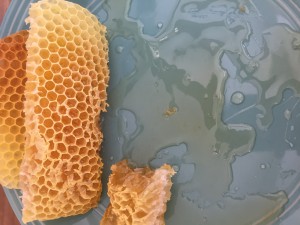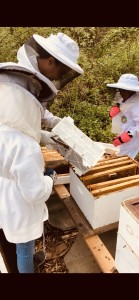
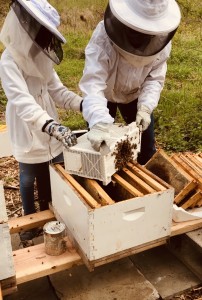
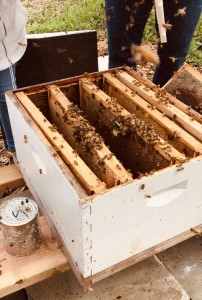
I’m a Connecticut beekeeper now! Installed two packages about three weeks ago. Fun! I have two new breeds of bees – Carniolan and Saskatraz. Most hives in American are the Italian species. I figured it would be fun to try new varieties to see how they perform. Carniolan bees are known to have a strong build up of bees going into winter, although they start slower in the spring. Saskatraz are a relatively new variety of bees bred to withstand some of the ailments that have been decimating colonies. Even though it’s just been a few weeks, I’m seeing differences between the hives already. More on that later.
 kingsophia
kingsophia
Sittin’ on the Deck Today, Watching My Hive Swarm Away
They swarmed! I knew it was coming given all the swarm cells, but I was hoping maybe all the splits I made would prevent the swarming. Well, not for this hive. Check out all the excitement.
After they swarmed, I noticed a few bees hovering over a shrub. Sure enough that’s where they landed! They were visible and reachable rather than way up in a tree top where I definitely wasn’t going to go. I got my shear and clipped my way through thorns and thickets until I cleared enough to have a good look. Here’s the cluster somewhere in there is the queen. Because of her strong pheromones, they didn’t pay much attention to me. I was basically chasing down thousands of bees like a bee bounty hunter
Then I got them in the box. Carefully. VERY carefully, cutting branch by branch.
Finally, I was able to get them in a nuc box. I’m a little nervous though. Take a look at this. Doesn’t it look like they’re all leaving? We’ll see what happens tomorrow. I’m pretty sure I got the queen in there. If that’s right, then they’ll stick around. If it isn’t, then somewhere in the woods behind my house there are ten to twenty thousand bees hanging out and democractically deciding what will be their permanent home.
Bee flight
Today was the warmest day of the year so far, and the bees were excited to be out. Saw lots of drones so they’re probably already out mating at drone bars! Really, it’s true. They go to “congregations” and their only task is to mate. Which by the way is a fatal act because their, um, male parts stay with the queen they mate until she finds the next drone who will remove it. And so on and so on, until she is all done and heads back to the hive with all the eggs she’ll need for the rest of her life. The drones are stuck between a rock and a hard place. If they don’t mate, eventually the worker bees back home will stop allowing them into the hive to be fed and cared for. Rough life, and these ladies don’t play.
Mild Winter
I was so busy beekeeping at the end of the summer last year, I didn’t have the bandwidth to focus on blogging. So, I have lots to share. At the height of the summer I had five hives! That’s after starting with just two nucs. By the start of the fall, one hive swarmed, and I lost a queen in another so I had to combine those two hives to end up with four. And they all survived the winter! As a matter of fact, the winter was so mild, one very industrious colony started making honey in late February. Check it out! They built that comb on the inside of the cover of the hive and started making honey from some very early blooming.
I learned how to make be fondant and fed them through the winter once they ran out of honey stores. Spent a lot of anxious time in the cold with my ears pressed to the hive to make sure they were buzzing away in there, all clustered up.
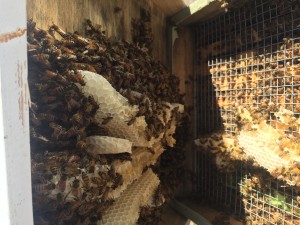
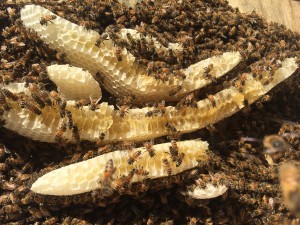
Bees at the Bar
A few days ago, I saw the bees clustered around the hive entrances after a hot day and got really nervous that they were getting ready to swarm. Until then, the bees would head inside once the sun started going down. On this particular night by 8:30pm they were still in a bunch outside, and the numbers were growing. I thought for sure they’d be gone by morning having swarmed in a tree out of my reach. It didn’t happen. The next day they huddled again, and then they did the same thing again on another warm day. Turns out, this is how they cool off. They were also hanging out by the container pond I set up for them as a water source. Lesson: bees have chill.

June Bees
Guess what? I did another split! Up to six colonies now. One of the hives was getting crowded, and I didn’t have a spare box. Rather than risk a swarm, I picked two frames with full of covered brood and newly laid cells, and put them in a nuc box. That induced the making of a queen. It’s been a week and you’ll see in the pic that they’re raising a queen! The red circle is the supersedure cell (queen in the making), the green circle is a hatching worker bee. In a little over a week, if all goes well, there’ll be a new queen hatching. Cross your fingers.
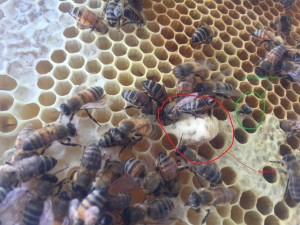
Tour de Backyard
Maybe you’ve considered getting a couple of hives, or maybe you’re just intrigued by the curious life of an apiary. Here’s a video of my backyard so that you can see one example of the kind of space necessary to keep bees. I live in the suburbs, and things are going fine so far with beekeeping in the backyard – all two months! I checked in with my next door neighbors before I started. Chatted with them a little bit about what to expect and why, and they were fine.
You can keep bees in more densely populated urban neighborhoods too. There is a growing number of rooftop beekeepers, and right on the concrete slab behind a townhouse you can place a hive stand and get started, if you are so inclined. Be sure to check your HOA bylaws, and city code. Many municipalities are recognizing the importance of pollinators like bees, and doing what they can to support, or at least allow, beekeeping. There is also the option of partnering with someone who has space and wouldn’t mind hosting. There’s plenty of that going on too.
I’m no videographer, but I hope this gives you a sense of what it’s like in my bee yard.
